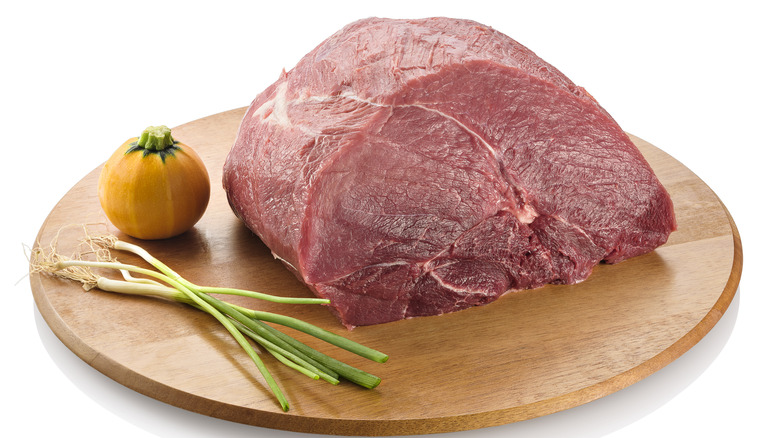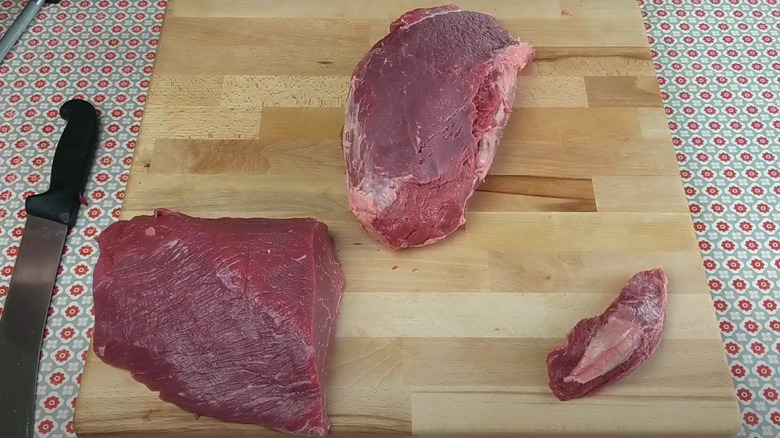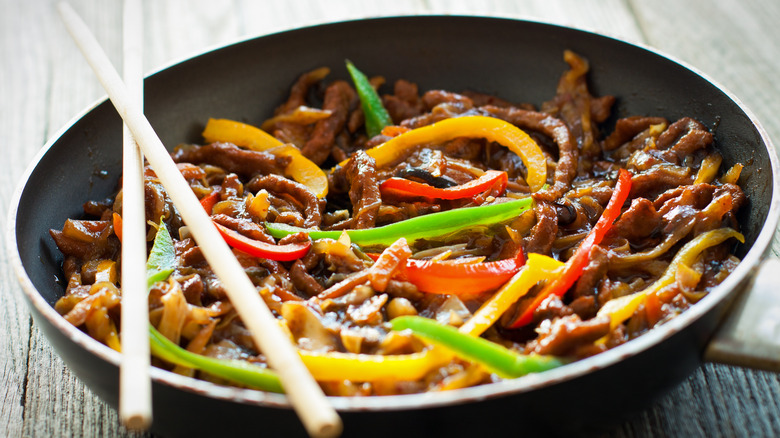What Is A Beef Knuckle And What Can You Do With It?
All the different cuts of beef can get a little confusing, to say the least. The same piece of meat cut at two different angles will have two different names. A commonly known cut in the United States, like a New York strip, may be known as a porterhouse in the United Kingdom or Australia. Order a porterhouse steak at an American steakhouse, and you will be served a behemoth with a New York strip, also called the top loin, hanging off one side of the bone with the full beef tenderloin on the other.
But what is beef knuckle? You might know it by a different name. Beef knuckle also has many, many names — sirloin tip, thick flank, ball tip, ball of the round, to simply name a few. It is located just above the knee of the cow and is a subprimal cut, which simply means that it is cut from a larger piece. In this case, the larger piece is the beef round, which comes from the leg and rump of a cow. The beef knuckle is no small thing though — the whole piece can range from 9 to 15 pounds. It is economical, flavorful, very lean, and though, on the tough side, it can definitely be tenderized.
What are the different parts of the beef knuckle?
The beef knuckle needs to be further trimmed and divided into its main muscle groups. First, the knuckle heart, or bullet, is separated from the rest of the knuckle — the femur and wedge muscles. There is quite a bit of connective tissue, silver skin, and gristle that needs to be removed, which you can certainly do yourself with a sharp knife and a little patience. Save the trimmings to make stock, broth, or consommé, or finely grind them to incorporate into beef mince or homemade sausage.
The femur muscle is best cut into cubes to use in dishes like beef bourguignon, stroganoff, or a Sunday red sauce — there are tons of ways to make braised beef. It also makes for great ground beef. The wedge muscle, because of its shape, can be cut into very thin steaks, like a sort of minute steak. As the name implies, these are meant to be cooked quickly. Any longer than a couple minutes and these steaks will get tough. Wrap them in prosciutto for a saltimbocca, cut into strips for a beef stir-fry, or pound out with a meat mallet for a milanesa.
The bullet muscle has a piece of silver skin through the middle. Once you remove it, you are left with two large muscles that can also be sliced into steaks, diced, or cut into strips. Make sure to always cut against the grain — this intersects muscle fibers making for a more tender bite.
How to cook with beef knuckle
When sold in markets, the different muscles of the beef knuckle can be known as tip center, tip side, or tip bottom, but those names can vary, so definitely ask your butcher if you're not sure. Whichever part you use, all of them will be lean, so try introducing fat and flavor with marinades, brines, or braises. Incorporating something like green papaya or pineapple into a marinade will tenderize tough cuts because the natural enzymes break down collagen. Just don't leave the meat to marinade for too long, or it can pass from melt-in-your-mouth to mush.
If you aren't using a marinade, you can also use a meat mallet, an electric tenderizer, or a good old rolling pin to whack some tenderness into the flesh. If you don't want to go the low-and-slow route, cook very thin slices or strips on high heat for just a minute or two — think stir-fry with fresh veg and a light glaze, served over noodles or a bed of brown rice. With a beef knuckle, you have a lot of options — and meat — to work with.



